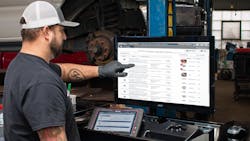For predictive maintenance to work with CVs, data must grow
Predicting future downtime is easier said than done. Because data and probability are involved, sample sizes matter with a trustworthy predictive solution. The more historical data that’s available to analyze, the more accurate the prediction will become.
“You’ve got to have a certain amount of history to train the system so that it kind of understands what the trends are,” explained Ben Johnson, Mitchell 1 director of product management.
Because of this, at Mitchell 1, “there’s nothing commercially available, but we are evaluating who to partner with and how to bring to bear more predictive analytics,” Johnson noted.
Even so, Mitchell 1, which leverages repair information from its ProDemand platform, has more than enough to data to make highly accurate predictions when a solution is commercialized.
“In our data pool, we’ve got around a billion repair orders (and it grows by about 40 to 50 million a year) that we derive value from,” said Johnson, who added that the company invested “a ton of money” into an artificial intelligence that focuses on transportation.
Consumer vehicles, along with lighter commercial vehicles up to Sprinter vans to Ford F-350s, have by far the most data collected.
“On the light vehicle side, you give me any year, make, and model and ask me when something’s gonna break, and I can tell you,” Johnson asserted.
There is still work to be done in heavy-duty, though.
“It’s just a matter of getting the amount of raw data to run through an AI system so that we know that we can trust the results,” he said. Another major challenge for predicting heavy-duty more accurately is the variety of duty cycles and regions. The same truck with the same engine will wear differently based on regional or longhaul, as well as in the mountains versus mostly flat terrain.
Even with that confidence in light-duty, he said Mitchell 1’s insights are used more reactively when a vehicle comes into the shop. If, hypothetically, a pickup comes in with a mass airflow sensor trouble code, and the technician also receives a certain power supply DTC, then the software can narrow the problem down.
On a virtual call, Johnson brought up the ProDemand light-vehicle tool SureTrack, and selected a 2016 6L Chevy Silverado, which had 138,000 different repair orders. Johnson demonstrated how a user can obtain data on the most frequent trouble codes, replacement parts, and symptoms.
After a few clicks he found for a certain DTC that a defective mass airflow sensor was the most prevalent culprit. Based on that, Johnson said a technician can validate and prove if that is the real root cause.
“We can look to see what the mileage is that this sensor typically fails at, and it looks like around 100,000 miles is the peak of it,” Johnson said while diving into the data. “So, if you’re dealing with a vehicle with only 40,000 miles, you might look at connectors or something like that, because the sensor is really not in its normal failure range.”
In this low-level use of predictive data, the human element is still very critical.
“We never ever say, ‘Because of this code, replace that part.’ You do still need the human to pop the hood,” Johnson said. “You need the human to say, ‘Yeah, the AI didn’t see that mice got in here and chewed up the wiring to this mass airflow.”
Johnson also stressed, as far as Mitchell is concerned, AI and predictive tools “will never replace the human and we don’t intend to.”
Instead, these should be looked at as the ability to help narrow down a location from a global perspective to a country-, state-, and county-level.
“We might get them into the right house,” he reasoned, “but even if we can’t get them there, we’ve done so much for them instead of making them try to navigate that world and figure it out.”
About the Author

John Hitch
Editor-in-chief, Fleet Maintenance
John Hitch is the award-winning editor-in-chief of Fleet Maintenance, where his mission is to provide maintenance leaders and technicians with the the latest information on tools, strategies, and best practices to keep their fleets' commercial vehicles moving.
He is based out of Cleveland, Ohio, and has worked in the B2B journalism space for more than a decade. Hitch was previously senior editor for FleetOwner and before that was technology editor for IndustryWeek and and managing editor of New Equipment Digest.
Hitch graduated from Kent State University and was editor of the student magazine The Burr in 2009.
The former sonar technician served honorably aboard the fast-attack submarine USS Oklahoma City (SSN-723), where he participated in counter-drug ops, an under-ice expedition, and other missions he's not allowed to talk about for several more decades.
